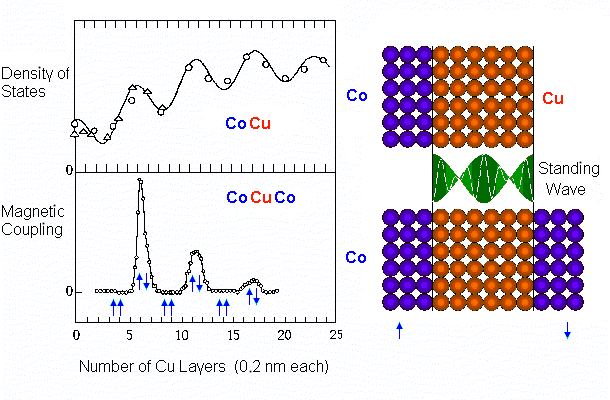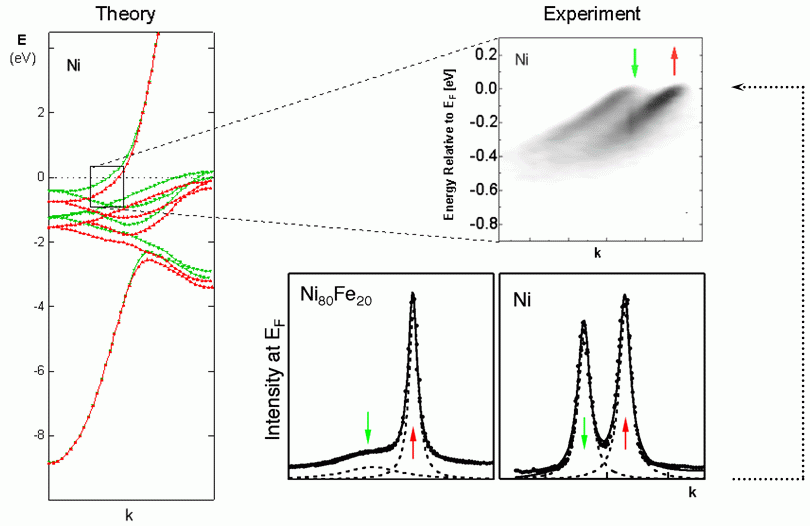
Giant magnetoresistance (GMR) reading heads consist of sandwiches of cobalt, copper, and permalloy (nickel-iron) that change their electrical resistance when exposed to the magnetic field of a stored bit. The discovery of this effect was recognized by the 2007 Nobel Prize in Physics. The sandwich structures are known as spin valves, since they preferentially transmit electrons of one spin orientation. A related phenomenon is oscillatory magnetic coupling, an oscillation in the magnetic orientation of two layers with film thickness.
To find out which electrons are producing these effects we have investigated their energy levels by inverse photoemission. Thereby, low energy electrons impinge onto the surface and drop into unoccupied energy levels emitting ultraviolet photons. This study discovered quantized electronic states in magnetic multilayers that are connected to their special properties.
The figure shows periodic changes in the density of electron states when the thickness of a copper film is changed, just a couple of atomic layers at a time (top panel). A way of understanding the experiment is shown on the right: Electrons in the Cu film are acting like waves and give maximum intensity when an integer number of oscillations fits into the film. These structures can be viewed as the smallest man-made interferometers, right at the atomic limit. They allow us to map out the wave function of electrons.

It turns out that the density-of-states maxima are correlated with oscillations of the magnetic coupling in multilayers (bottom panel, from Qiu et al., Phys. Rev. B 46, 8659 (1992)). The magnetoresistance oscillates with the same period. This provides the clue for understanding these magnetic phenomena as the effects of quantized electron levels in nanostructures. By manipulating the interfaces in magnetic multilayers one can enhance the spin-dependent reflectivity and optimize the sensitivity of a magnetic reading head.
Review of magnetic nanostructures:
Himpsel et al., Advances in Physics 47, 511 (1998).
Magnetic Quantum Well States:
Ortega et al., Phys. Rev. Lett. 69, 844 (1992);
Ortega et al., Phys. Rev. B 47, 1540 (1993);
Himpsel, Science 283, 1655 (1999).
Beyond the GMR effect in reading heads there are several other magnetic phenomena that can be incorporated into electronic devices. For example, the magnetoresistance induced by spin-polarized tunneling lies at the core of magnetic random access memory (MRAM) and is now used in magnetic reading heads as well. The new field of magnetoelectronics has developed, where spin currents are used instead of charge currents. For that, it is important to know how to produce spin-polarized electrons, how to filter them, and how to detect their spin. Electrical and magnetic measurements provide practical information, but they integrate over all momenta, that is, they do not distinguish between electrons moving in different directions and at different speeds.
The most detailed way to resolve the momenta of these electrons is by angle-resolved photoelectron spectroscopy. This technique is able to measure the complete set of quantum numbers of electrons in solids. The figure below shows a theoretical plot of the quantum numbers energy (E) and momentum (k) for the two spin directions (red and green). The photoemission experiment on the right zooms in on the electrons that are relevant to magnetoelectronics. These are those close to the Fermi level (E=0). The intensity of these electrons is plotted versus their momentum in the two panels at the bottom right. From the k-separation of the two spin peaks one can infer the magnetic moment, from their relative intensity the spin-polarization, and from their width the mean free path of the electrons.

Spin currents can be manipulated by spin doping, where magnetic atoms are introduced as dopants for selecting one type of spin carrier. For example, adding iron to nickel suppresses the green spins, but not the red spins in the figure above. The Fe/Ni ratio of 20/80 corresponds to permalloy, a dominant material in magnetoelectronics.
References:
Petrovykh et al., Appl. Phys. Lett. 73, 3459 (1998).
Altmann et al., Phys. Rev. B 61, 15661 (1998).
Altmann et al., Phys. Rev. Lett. 87, 137201 (2001).
Supported by NSF-DMR